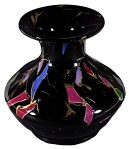Text by Laura Short, Gallery Attendant
 Though this vase may look like it’s from the 1980’s, it was really manufactured during the Victorian era. It is called Sicilian ware, and was probably the first art glass produced by the Mount Washington Glass Company. Frederick Shirley, manager of the company, was known for his innovative glass designs, and applied for 3 patents between 1878 and 1879 for his new Sicilian Glass. The recipe supplied in the patent lists “lava or volcanic slag” as part of the ingredients that give the glass its coloring, which is why many collectors also call it “Lava glass”. The chemical components of lava and glass are very similar, so it is relatively easy to add lava to a glass mixture. In fact, obsidian is a natural glass formed by slowly cooling lava. The lava used for Sicilian ware was supposedly from Mount Etna on the eastern coast of Sicily, Italy – thus the source of its name.
Though this vase may look like it’s from the 1980’s, it was really manufactured during the Victorian era. It is called Sicilian ware, and was probably the first art glass produced by the Mount Washington Glass Company. Frederick Shirley, manager of the company, was known for his innovative glass designs, and applied for 3 patents between 1878 and 1879 for his new Sicilian Glass. The recipe supplied in the patent lists “lava or volcanic slag” as part of the ingredients that give the glass its coloring, which is why many collectors also call it “Lava glass”. The chemical components of lava and glass are very similar, so it is relatively easy to add lava to a glass mixture. In fact, obsidian is a natural glass formed by slowly cooling lava. The lava used for Sicilian ware was supposedly from Mount Etna on the eastern coast of Sicily, Italy – thus the source of its name.
During the Victorian period archaeology blossomed as a major academic pursuit. Excavations going on throughout the Mediterranean, Middle East, and Egypt brought many fine examples of ancient art to museums throughout Europe and the United States. These included discoveries of ancient glass and pottery from places such as Troy and Mycenae. Public interest in the ancient world was further fueled by the 1876 World Fair—the Centennial Exhibition held in Philadelphia, Pennsylvania, which included modern and antique works from all over the world. Despite the psychedelic appearance, Shirley designed it “especially for the imitation of antique ceramics, mosaic, and lava pottery-ware, and […] reproductions of the works of ancient maters”. Interestingly, articles written on the subject of Sicilian ware prior to the 80’s describe it as being reminiscent of art deco, probably due to the shape. Somehow, Shirley managed to create a glassware that was both in vogue and yet avant garde.
Our piece is representative of the Sicilian ware style– most works were squat with a narrow opening, and were mostly vases, though lamps were also produced. While the grand majority of Sicilian ware is black, there are some pink or raspberry examples. Though the name relates to components of the glass and not the decoration, most have the large brightly colored pieces of glass (backed in white so they could be seen more clearly) and gilding, like ours. Rarely there are some with decorations over this. Interestingly, illustrations in some of Mr. Shirley’s patents include ‘oriental’ figures, which was a popular motif at the time, though there are no known examples of this design in existence.
To view this piece, and other fine examples of Mount Washington glass from our collections, please come visit our current exhibition, Gilded Age Grandeur, on display until June 23, 2013.